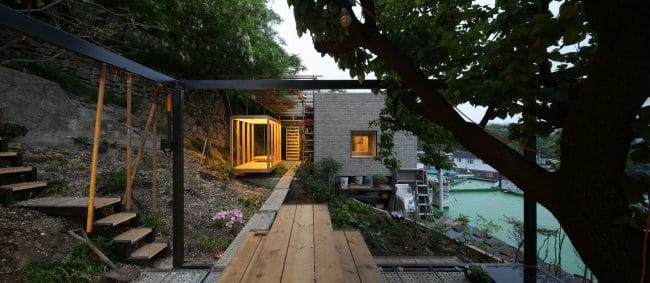이 프로젝트에서 우리가 보관하고 있는 현장 가설재를 많이 사용했다. 집이기도 했지만 자재의 보관을 염두에 둔 것으로서 다른 현장에서 필요하면 다시 뜯어서 간다는 가벼운 생각으로 시작된 것인데 일이 좀 커졌다. 이 집에서 가설재를 사용하면서 얻어진 장점을 말한다면 언제든 어디서든 구하기 쉽고, 공사기간이 무척 빠르며, 기술 인력을 쉽게 구할 수 있고, 일정한 규격으로 인해 균제적 건축이 가능하다는 것이다. 혹시 불법건축물로 적발 되었을 경우가 생기더라도 현재 건축중이라고 말하면 된다. 무엇보다 좋은 점은 재료사용에 대한 임상치를 스스로 테스트할 필요가 없단 것이다. 오랜 동안 여러 현장에서 사용되면서 진화된 결과를 사용하는 것이기 때문이다.
새로운 시도가 하나 더 있다.
“이 집에서 카다로그있는 것은 하나도 없어요.” 토미후지모리 교수가 이 집에서 학교수업을 진행하며 학생들에게 한 말인데 기성제품을 사용하지 않고 대부분 손으로 제작한 물품들을 사용했다는 것이다. 화학성분의 접착제는 물론이고 그것을 사용해서 만든 재료인 합판과 엠디에프등 공장제품을 거의 사용하지 않았다. 생각보다 힘든 일이었지만 시중에서 그렇지 않을 재료를 구할 수가 없었으므로 선택의 방향성만큼은 명백했다. 이렇게 성취된 결과를 평가한다면 공장제품에 비하여 상당히 비경제적이며, 훨씬 많은 시간이 소요되며, 기계로 만들 물품에 비해 정밀도가 떨어지고, 더 많은 시행착오를 겪어야 했지만 충분히 의미로운 작업이라는 믿음을 얻었다. 그리고 우리가 수행해야 할 미래의 방향도 여기서 찼았다. 의심없이 비경제적이며, 더 오래걸리고, 계속 삐뚤빼뚤하며, 시행착오마저 여러번 복재되더라도 이런식의 반 유형적인 작업방식을 계속 유지하는 것이 옳다고 생각하겠다는 것이다. 집보다 삶이 더 중요하기 때문이다.
I started the project with a light-hearted attitude, thinking that we can always take back these resources if we need it at another location, but the project became bigger than I thought. The advantages of using available resources is that they are easy to find anywhere and anytime, they are a quick fix, can find workers easily, and aids with a well-balanced construction programme. Moreover, if the building is determined as illegal, it is easy to tear down the building or argue that it is still in the process of being constructed. Professor Tomii Masanori told his students while lecturing in this house that ‘nothing in this house can be found in catalogues’, referring to the fact that the house was filled with hand-made goods rather than off-the-shelf products. Although it was difficult than originally thought, the goad of the plan was clear because it is almost impossible to find non-factory made materials in stores. To assess the results, the process was vastly uneconomical than using factory-produced goods, consumed more time, lacks precision than machine-made products, and caused more trials and errors. However, I learned that it was worth the endeavor and found the direction for the way ahead. I will continue to believe that this no-doubt uneconomical, time consuming, far from precise, prone to error, atypical method is the right way-because life is more important than the house.
Kim Jaekwan a principle of moohoi Archtrecture Studio is known for his past designs for protestant church buildings such as Kangjeong Presbyterial Church, and Pulhyanggi Presbyterian Church. However, of late he has started enjoying renovating wear and tear, old, dilapidated and unfashionable houses by disassembling, measuring, drilling, digging and patching them up. He now lives as a residential design builder [carpenter] enjoying the company of rusty iron, bent metal, stubborn rock, trees and wind, light and water.
http://www.archdaily.com/778624/cheolmins-jip-soori-moohoi-architecture-studio

